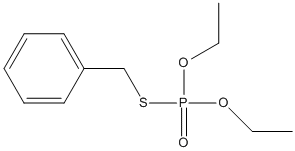Kitazin
General
Type : Organophosphate,Organothiophosphate,Fungicide,Not A\/B H target,Sulfur Compound
Chemical_Nomenclature : diethoxyphosphorylsulfanylmethylbenzene
Canonical SMILES : CCOP(=O)(OCC)SCC1=CC=CC=C1
InChI : InChI=1S\/C11H17O3PS\/c1-3-13-15(12,14-4-2)16-10-11-8-6-5-7-9-11\/h5-9H,3-4,10H2,1-2H3
InChIKey : XFMJUIKWKVJNDY-UHFFFAOYSA-N
Other name(s) : Kitazine,Kitazin P,Ricide,Isoprobenphos,Iprobenphos,EBP,IBP,Ritacin-P,SCHEMBL7174164,S-benzyl O, O-diisopropyl phosphorothiolate
MW : 260.29
Formula : C11H17O3PS
CAS_number : 13286-32-3
PubChem : 25834
UniChem : XFMJUIKWKVJNDY-UHFFFAOYSA-N
IUPHAR :
Wikipedia :

Target
References (3)
| Title : Characterization of cholinesterases in marbled sole, Limanda yokohamae, and their inhibition in vitro by the fungicide iprobenfos - Jung_2007_Mar.Environ.Res_63_471 |
| Author(s) : Jung JH , Addison RF , Shim WJ |
| Ref : Mar Environ Research , 63 :471 , 2007 |
| Abstract : Jung_2007_Mar.Environ.Res_63_471 |
| ESTHER : Jung_2007_Mar.Environ.Res_63_471 |
| PubMedSearch : Jung_2007_Mar.Environ.Res_63_471 |
| PubMedID: 17300836 |
| Title : Effect of a mixture of iprobenfos and malathion on the development of malathion resistance in the mosquito Culex pipiens pallens Coq - Tao_2006_Pest.Manag.Sci_62_86 |
| Author(s) : Tao L-M , Yang J-Z , Zhuang P-J , Tang Z-H |
| Ref : Pest Manag Sci , 62 :86 , 2006 |
| Abstract : Tao_2006_Pest.Manag.Sci_62_86 |
| ESTHER : Tao_2006_Pest.Manag.Sci_62_86 |
| PubMedSearch : Tao_2006_Pest.Manag.Sci_62_86 |
| PubMedID: 16235270 |
| Title : [A method of using synergists in studying the level of activity of enzyme systems and their participation in the mechanism of action of insecticides on insects] - Eremina_1997_Izv.Akad.Nauk.Ser.Biol_3_320 |
| Author(s) : Eremina O , Roslavtseva SA |
| Ref : Izv Akad Nauk Ser Biol , 3 :320 , 1997 |
| Abstract : Eremina_1997_Izv.Akad.Nauk.Ser.Biol_3_320 |
| ESTHER : Eremina_1997_Izv.Akad.Nauk.Ser.Biol_3_320 |
| PubMedSearch : Eremina_1997_Izv.Akad.Nauk.Ser.Biol_3_320 |
| PubMedID: 9303755 |